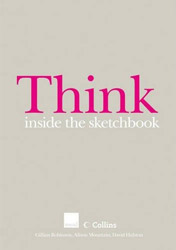Think inside the sketchbook
Fiona MacLellan, University of Northampton
Robinson, G., Mountain, A. and Hulston, D. (2011), Collins Education, an imprint of HarperCollins Publishers. .......... The title of this book caught my attention, in part, due to being responsible for a collection of artists’ book and knowing very little about the rationale behind these artefacts. When the book arrived for review it was a large scale item that makes good use of graphic desig...

Authors: Gillian Robinson, Alison Mountain and David Hulston
Publisher: Collins Education, an imprint of HarperCollins Publishers
Publication date: 2011
ISBN: 978-0-00-743479-4
Price: £25.00
The title of this book caught my attention, in part, due to being responsible for a collection of artists’ book and knowing very little about the rationale behind these artefacts. When the book arrived for review it was a large scale item that makes good use of graphic design, providing lots of blank space allowing the reader to stop and think rather than being bombarded with information at all times. The book is a useful introduction to the concept of the sketchbook, or ‘thinking book’ as they are often referred to in the text.
The book begins with some thoughts on what sketchbooks are and who uses them, and by doing this it makes it clear that sketchbooks are not limited to artists and are in fact used in many different careers often under other names, e.g. lab book. This first chapter also makes some suggestions at ways in which these books could be used.
The second chapter focuses more on the people behind the sketchbook, and gives examples of sketchbooks from many different areas of life from artists and designers to teachers, mathematicians and students. Each example used has images and either a description or thoughts from the sketchbook owner, giving a wonderful insight into the reasons behind sketchbooks.
Chapters three and four showcase some aspects of the benefits of sketchbooks and what sort of things might be included, specific examples of both of these are used in relation to using sketchbooks with children in schools. These chapters start with the idea of a sketchbook as a place to think and explore, but also link to the idea of the sketchbook as a research journal. It also focuses on why things are put into the book or not and the decisions behind the journal being as important as the actual content. Many of the examples suggest encouraging reflection in that way should be included in the sketchbook.
Chapter five covers ideas on how to create a sketchbook and incorporate the use of sketchbooks into everyday life. It offers some suggested activities to get working with the books and reemphasises the myriad of different ways the sketchbook concept can be translated to a real object. The authors are keen to highlight that there is no right and wrong when creating sketchbooks, and they do this through not only the vast array of different examples and suggestions but also through reassurance.
Chapter six showcases seven different projects that have utilised sketchbooks. They offer useful reflection on the projects with comments on the problems and successes of using sketchbooks. The projects all come from schools and activities involving children, but offer suggestions and considerations that can be applied to any age group.
The book is heavily focused on childrens’ activities and as such some of the ideas and suggestions for activities may be a bit basic for use in Higher Education (other than for teacher training of course), however as a basic guide to sketchbooks and how they can be used it is accessible and easy to understand. I approached the book simply wanting to find out more about the topic and get a feel for why artists’ books or sketchbooks are so popular and the book met those needs, I would think that anyone who already has a good understanding of those basics may find the content less informative or interesting.
The second dimension, in my mind at least, is that of the book being a showcase for some wonderful examples of artists’ books, and some of the intention behind them. This second dimension is the redeeming feature of the book for anyone who already knows about sketchbooks and simply wants to widen their knowledge or experiences. Chapter two focuses on this aspect of the book and is understandably the largest chapter. The images within the book are really interesting to see and it’s enjoyable to read about their creation and see different interpretations of the same concept. My only complaint would be that some of the images were quite small, which when there is a lot of blank space in the book seems a shame, I would have much preferred larger images so I could really get lost looking at them.
Overall, the book is well thought out and covers everything that a basic book on the topic should, it wraps these thoughts and ideas up in a well presented item that not only looks lovely on a shelf or on display but is also packed full of ideas that can be used in everyday life and the creation of sketchbooks by individuals or in group contexts. The book would be a nice addition to a collection of artists’ books or as a talking point when introducing the concept of sketchbooks to students of any age. I loved seeing the vast array of different sketchbooks on display and having never thought of myself as a sketchbook user can now see parallels between the notebooks I use and the sketchbooks used by the students I work with on a daily basis.
Reviewer
Fiona MacLellan is Academic Librarian, Library and Learning Services, University of Northampton.


